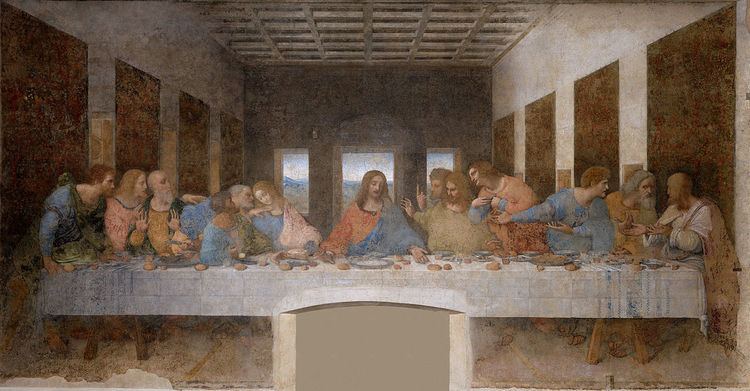 | ||
The Mass of the Lord's Supper is the Catholic Mass celebrated on the evening of Holy Thursday. It inaugurates the Easter Triduum, and commemorates the Last Supper of Jesus with his disciples, more explicitly than other celebrations of the Mass.
Contents
Many Anglican churches celebrate the Mass of the Lord's Supper (or the Proper Liturgy of Maundy Thursday). Depending on the jurisdiction, these rites are found in the Book of Common Prayer, the Anglican Missal or an alternative service book.
The Mass stresses three aspects of that event: "the institution of the Eucharist, the institution of the priesthood, and the commandment of brotherly love that Jesus gave after washing the feet of his disciples."
Structure
The Mass begins as usual, with the exception that the tabernacle, wherever placed, should be empty.
In the 1962 Missal (Roman rite), although white vestments and the Gloria in Excelsis are used, this is still Passiontide, so the "Judica me" is omitted at the foot of the altar, the "Gloria Patri" in the Introit and at the end of the Lavabo is omitted, and the Preface of the Cross is used. (The crucifixes, which have been covered during Passiontide, can today be covered with white instead of with violet.)
At the singing of the Gloria in Excelsis Deo, all the church bells may be rung; afterwards, they (along with the organ) are silenced until the Gloria of the Easter Vigil.
The Liturgy of the Word consists of the following readings:
After the homily, which should explain the three aspects of the celebration mentioned above, the priest who is celebrating the Mass removes his chasuble, puts on a linen gremiale (an amice is often used for this purpose), and proceeds to wash the feet of a number of people (usually twelve, corresponding to the number of the Apostles)
There are special formulas in the Eucharistic Prayer to recall that the Mass of the Lord's Supper is in commemoration of Jesus' Last Supper.
Sufficient hosts are consecrated for the faithful to receive Communion both at that Mass and on the next day, Good Friday. The hosts intended for the Good Friday service are not placed in the tabernacle, as is usual, but are left on the altar, while the priests says the postcommunion prayer. Then the priest incenses the Blessed Sacrament three times and, taking a humeral veil with which to hold it, carries it in solemn procession to a place of reservation somewhere in the church or in an appropriately adorned chapel. The procession is led by a cross-bearer accompanied by two servers with lit candles; other servers with lit candles follow and a thurifer immediately precedes the priest.
On arrival at the altar of repose, the priest places the vessel with the Blessed Sacrament in the tabernacle there, leaving the door open. He then incenses it and closes the tabernacle door. After a period of adoration, he and the servers depart in silence.
The continuation of Eucharistic adoration is encouraged, but if continued after midnight should be done without outward solemnity. In the Philippines and several other Catholic countries, the faithful will travel from church to church praying at each church's altar of repose in a practice known as Seven Churches Visitation or Visita Iglesia. The Blessed Sacrament remains in the temporary place until the Holy Communion part of the Good Friday liturgical service.
Stripping of the Altar
In the form of the Roman Rite in use before 1955, there was no washing of the feet, which could instead be done in a separate later ceremony, and the Mass concluded with a ritual stripping of all altars, except the altar of repose, but leaving the cross and candlesticks. This was done to the accompaniment of Psalm 21 (Vulgate) (Deus, Deus meus) preceded and followed by the antiphon "Diviserunt sibi vestimenta mea: et super vestem meam miserunt sortem" (They divided my clothes among them and cast lots for my garment).
Since 1955, the altar is stripped bare without ceremony later.
History
The celebration of a Mass in the evening of Holy Thursday began in late fourth-century Jerusalem, where it became customary to celebrate the events of the Passion of Jesus in the places where they took place. In Rome at that time a Mass was celebrated at which penitents were reconciled with a view to participation in the Easter celebrations. The Jerusalem custom spread and in seventh-century Rome the Pope celebrated a Mass of the Lord's Supper on this day as well as the Mass of Reconciliation. By the eighth century, the Masses became three: one for reconciliation, one for blessing the holy oils and a third for the Last Supper. The last two were in reduced form, being without Liturgy of the Word. Pope Pius V's reforms in 1570 forbade the celebration of Mass after noon, and the Mass of the Lord's Supper became a morning Mass and remained so until Pope Pius XII's reforms in the 1950s.
The washing of feet that is now part of the Mass of the Lord's Supper was in use at an early stage without relation to this particular day, and was first prescribed for use on Holy Thursday by a 694 Council of Toledo. By the twelfth century it was found in the Roman liturgy as a separate service. Pope Pius V included this rite in his Roman Missal, placing it after the text of the Mass of the Lord's Supper. He did not make it part of the Mass, but indicated that it was to take place "at a suitable hour" after the stripping of the altars. The 1955 revision by Pope Pius XII inserted the rite into the Mass.
